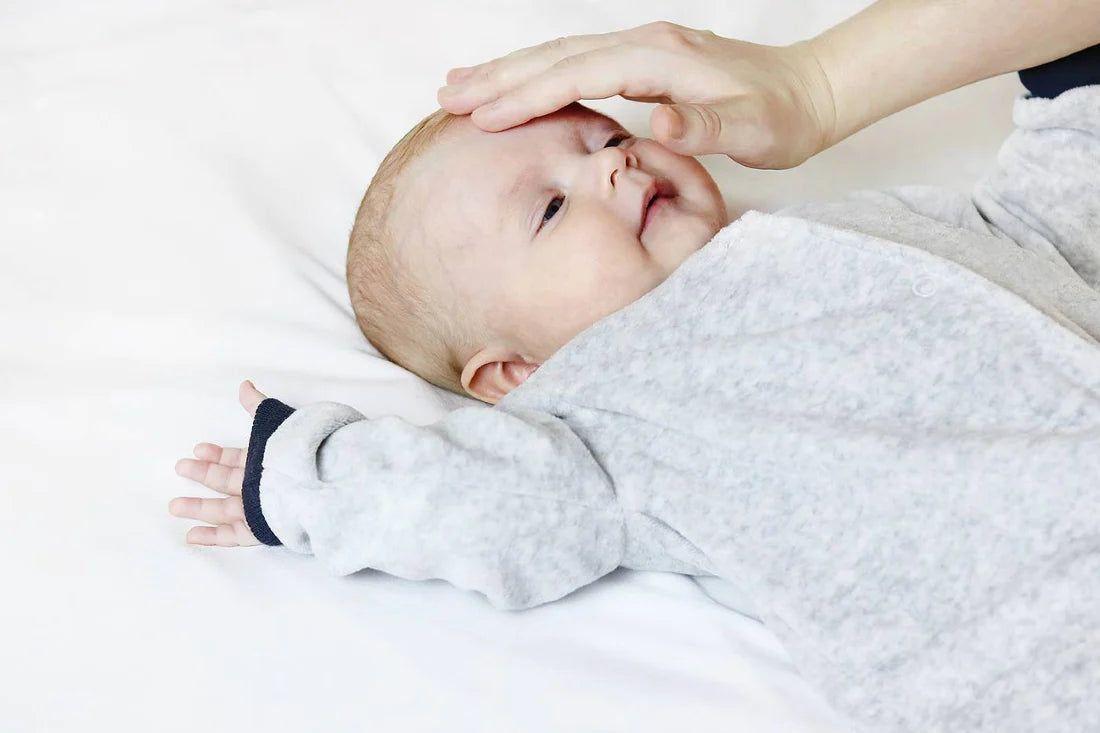BABY
Is Your Baby Overheating? Signs Your Baby Is Too Hot
How to tell if Baby is too warm.

Written by
Dr. Harvey Karp

SHARE THIS ARTICLE
PARENT PICKS
Bestsellers
BABY

Written by
Dr. Harvey Karp

SHARE THIS ARTICLE
Bestsellers
You never want your little one to be too hot! If your baby is overheating, she is likely to be uncomfortable, her sleep may suffer, and she may get heat rash. But, there is an even more serious concern: Overheating can raise the risk of infant sleep death, also called SIDS.
Studies have shown that thick clothing, too many layers, and high room temperatures increase the risk of SIDS. While it may seem counterintuitive, infants are at higher risk of SIDS during the winter months. That is because parents worry that their baby may get cold and they try to prevent that by overdressing them or turning on the boiler.
A normal temperature in babies is considered to be around 36.4 degrees celsius. Overheating and fevers in babies are considered to be around 38 degrees celsius or above. Keep in mind that temperatures can vary in your baby throughout the day.
Luckily, there is an easy way to tell if your baby is too hot. Touch her ears and neck. If her ears are red and hot and her neck is sweaty, your baby is too warm. Dress her more lightly or cool the room.
Below you will find a few signs of baby overheating
The room should be kept between 20°C to 22.2°C. You can actually measure the room temperature with a thermometer, but in general, the temperature should not be too cool or too warm to an adult.
In hot weather, it is fine to let your baby sleep in just a nappy and wrapped in a light swaddle blanket. Of course, you should not overdress your baby or overheat the room, whether she is swaddled or not.
If your baby is too warm, she may become restless, which can lead to less sleep for her… and you! To avoid that, do not over-bundle your child for naps or at bedtime with extra layers of clothing or hats. Hats are especially problematic because covering the head reduces the baby’s ability to cool down. Also, in the middle of the night, a hat might accidentally slip over your little one’s face and cause breathing difficulties. Never use blankets (a safe baby cot is a cot free of toys, blankets, and all objects except a dummy) and never use electric blankets or heating pads under your baby. These overheat infants and expose them to electromagnetic radiation.
If you believe your baby is overheating, then here are some steps that you can try to cool down your baby.
Babies develop heat rash when their salty sweat irritates the skin. It most commonly appears on their necks, armpits, chest, back, elbows, or thighs. The rash presents as little red dots (irritated hair follicles) and splotchy skin and can be accompanied by fever, chills, and bumps. If you think your child has heat rash, give your paediatrician a call. She may recommend that you sprinkle on a dusting of cornstarch powder—never talcum—to absorb excess sweat and prevent irritation.
The thing to keep in mind is that babies cannot regulate their body temperature well, so you want to avoid extreme hot and cold. If you are ever not sure, do the “ear check” to be safe!
***
Happiest Baby’s SNOO Sack and Sleepea Swaddle are made of 100% organic cotton and mesh, specifically designed to keep babies comfy. It is also the easiest and safest way to wrap your baby.
Disclaimer: The information on our site is NOT medical advice for any specific person or condition. It is only meant as general information. If you have any medical questions and concerns about your child or yourself, please contact your health provider. Breastmilk is the best source of nutrition for babies. It is important that, in preparation for and during breastfeeding, mothers eat a healthy, balanced diet. Combined breast- and bottle-feeding in the first weeks of life may reduce the supply of a mother's breastmilk and reversing the decision not to breastfeed is difficult. If you do decide to use infant formula, you should follow instructions carefully.